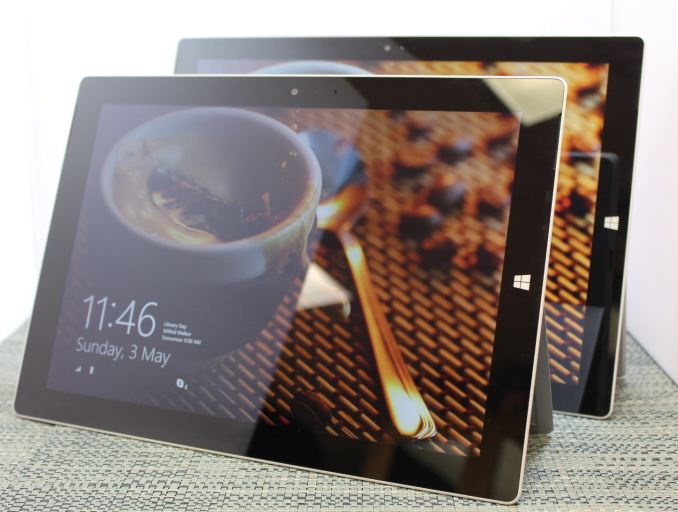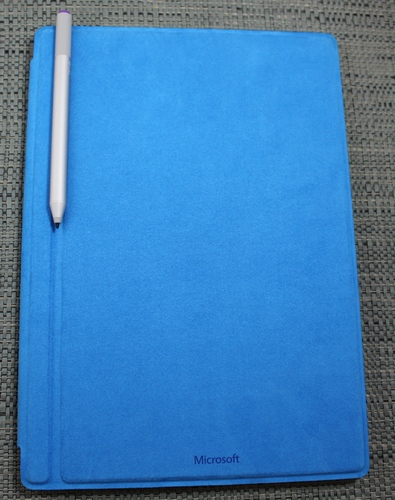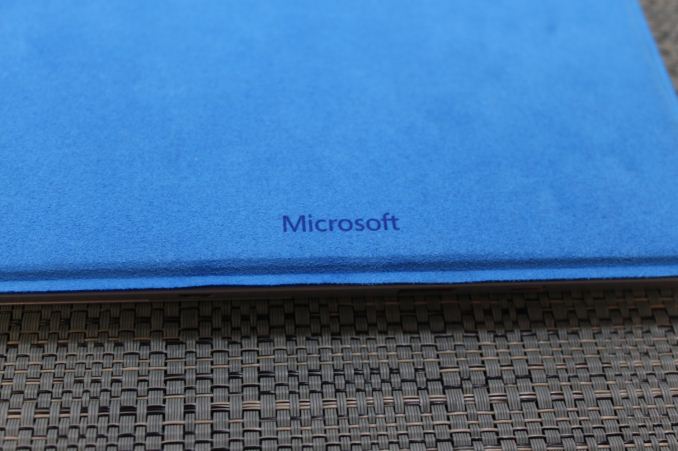The Surface 3 Review
by Brett Howse on May 4, 2015 9:00 AM ESTFinal Words
In the Windows space, there is quite a bit of variety in tablets. Some are well under $100, and some go over $1000. In this space, the Surface Pro 3 has done very well, establishing a name for itself with good performance in a small form factor. Microsoft is certainly trying to emulate this success with the Surface 3, and for good reason. With the Surface Pro 3, they got a lot right, so it makes sense to push the value line in the same direction.
The Surface 3 is superior to its predecessors in many ways. Where they were good, it is better. It keeps the wonderful magnesium chassis, but stretches it into a 3:2 aspect ratio. This alone is almost worth the price of admission, but it is just one of many changes made. I would argue that it is one of the most important changes to this tablet, and it makes it a better tablet and a better laptop. The kickstand has always been a staple of the Surface lineup, and adding the one additional step really helps make it even more usable in more scenarios. I wish it opened just a bit wider like the Pro model does, but that is a small gripe.
The move to x86 with the Atom x7-8700 was long needed. No longer is Surface and Surface Pro not able to run the same applications. Windows RT was always going to be a tough sell, but even more so since the Windows Store did not take off as quick as would have been necessary for RT to have a future. Once Intel shipped Bay Trail though, the writing was on the wall for Windows RT, since there was little reason to sacrifice the backwards compatibility of x86. The move to Cherry Trail in this model has provided a speed boost as well, and for light workloads it is more than sufficient. Plus, you could run anything that a Surface Pro could run, even if it will take a bit longer. That is an option that just did not exist before with the Surface line.
That being said, the SoC performance is where the price point dictates - around the good ARM products but poorer compared to Core. This is especially true when compared to the Surface Pro 3, but it is worth noting the SoC power draw between the two (14W vs 2W). That being said, the performance of the eMMC is a major drawback to how this device feels, especially in day to day use. Most of the time it isn't noticable, but when there is a bottleneck most of the time it was due to disk accesses.
From a long term usability standpoint, getting rid of the 32 GB model and having Surface 3 start with 64 GB is a big boost. 32 GB is a tough sell when you have the larger install footprint of Windows, as well as a recovery partition. Add in some Windows Updates, and a 32 GB model is going to be near capacity right away, and that really diminishes eMMC’s performance. Now the base model starts at 64 GB, and for just $100 more, you can opt for the 128 GB model which also has 4 GB of RAM. I personally think that would be $100 well spent, and if I was buying, that would be the model I would go for.
The accessories are also first rate. The keyboard is really quite good, and although the trackpad is small, it does work well when needed. It is a bit on the pricey side but it really does complete the Surface 3 and gives you the laptop capabilities in a nice cover. When I was using it as a tablet, I almost always removed the keyboard though, so it is certainly not a must have, but a really should have. Adding the pen to the lineup for this round was also a great move. Being able to use the Surface 3 for quick notes came in very handy, and I found the pen to be quite easy to glide over the screen, and accuracy was top notch. Of the accessories, the dock is likely not something the average consumer needs, but it really is a nice dock for storage and charging. At $199 though, it is too much for the average person to go for. For businesses though, it should come in very handy and should help the Surface 3 gain some traction there. It is not quite as good as the Surface Pro’s dock though, since this model lacks the proprietary docking port of the Surface Pro 3.
There is a lot to like about the Surface 3, but not everything is perfect. Battery life, especially when compared to other tablets, is well below average. This is despite having a display with a pixel density less than a lot of the competition, which means the Surface 3 should have an advantage in backlight power consumption. Display power draw is a huge concern, and perhaps the Panasonic one in the Surface 3 is not quite as efficient as others, especially Sharp’s IGZO lineup. The overall battery life is still decent though, and the much improved standby time is a big boon. However the charge rate is really a problem on this tablet, and it would have been excellent to see this new device embrace USB Type-C as the charging connector. Since it already has a full sized USB 3.0 port, there would be very little downside to moving to the new connector for charging, and it would allow for a reversible insertion as well.
I think though that the battery life is really the only real concern for the Surface 3. In the Windows space, there is no other tablet quite like this one, except maybe the Surface Pro 3, but that device is bigger, and heavier, and less useful as a tablet. It does have far more performance available, but for far more money up front.
Up to this point, I have not discussed the ability to use Surface 3 in your lap at all, and for good reason. For people out in the world that need to be able to use a device in their lap, then please just buy a notebook computer. Almost none of the 2-in-1 devices that I have tested have been especially good at that task, even those with true attachable keyboards. Only the devices like the Yoga 3 Pro which keep the processor in the base have the correct balance for this task. The Surface 3 can work in a pinch, but it is much better suited to be used on a desk with the keyboard attached if you need to use it as a notebook.
Pricing is the final piece of the puzzle. At $499, you get a decent spec with 2 GB of memory and 64 GB of storage. The $599 model bumps that to 4 GB of memory and 128 GB of storage. It is not inexpensive. Add in the keyboard for another $130 and the Surface 3 is getting close to the pricing of the ASUS UX305, which has a lot more performance available. The pen is another $50 on top. The base price of the Surface 3 is, I think, competitive, but adding in the accessories to really make it what it is advertised as ramps the price up in a hurry.
So with those caveats aside, we can finally get to the conclusion that you have likely guessed already. The Surface 3 is a great device. The build quality is really at the top level of any OEM out there. The form factor is finally the right one after two previous generations that got it slightly wrong. The weight is lighter than any previous Surface, and just as balanced. Performance of the x7 Atom CPU is great for light tasks, and if you need more than light tasks then this is not the device for you. As a tablet, it is great to use in either orientation, with the portrait mode being especially good now for browsing the web. The kickstand is improved, they keyboard is improved, the base tier steps up to 64 GB of storage, making it actually useful without immediately adding micro SD to the mix.
With Windows 10 right around the corner, the Surface 3 feels like Microsoft’s best attempt yet at creating a great tablet computer. If you in the market and you want a Windows 8.1 tablet, it would be worth your time to check out the Surface 3.













265 Comments
View All Comments
MrSpadge - Monday, May 4, 2015 - link
Using legacy apps (which are still called programs) should be fine with the pen. Except for the high DPI display - depending on how legacy the app exactly is.Alexvrb - Monday, May 4, 2015 - link
It runs touch-friendly modern apps (including Universal apps which will be getting a boost in the near future) as well as more traditional software. You can use just about any external accessory that you can with a regular PC. If you use the dock and a larger monitor this can even replace the desktop for many users. In many ways it is more versatile than the devices you mentioned.stephenbrooks - Saturday, May 9, 2015 - link
Actually a lot of programs designed for mouse input (click and drag) work pretty well on a touchscreen Windows machine. The main problem is the buttons tend to be too small for fingers.It would be great if Microsoft could have an option to magically enlarge GUI elements a bit when in touch mode.
jaydee - Monday, May 4, 2015 - link
When I say lack of apps, I mean as designed as portable tablet. That's what MS is touting, it's a tablet and laptop in one.Of course it has tons of apps as a Win8/10 device, but if that's all you're really after, why buy something that straddles the line between laptop and tablet? Why not an XPS 13 or Spectre x360? Proportionally few of those Windows apps tend to run real well on a 10" touch screen with a resolution of 1920x1280.
It just seems to be in an odd place. I'm not sure what it does really well, other than its display. CPU/RAM/SSD are all compromised as a laptop and it's too expensive for what it does as a tablet. It's not "bad" by any means, I really do *want* to like it, it just doesn't seem to do the laptop thing well enough, be a tablet at a low enough price point. And I'm someone who would like to replace my iPad Air with something convertible like this. But if I'm going to buy a laptop that can also be used as a tablet, it's either going to have to have higher performance, or be cheap enough to not feel bad replacing in a couple years, and I don't feel either with this (particularly with accessories). I'm much more apt to get the i5/8GB/256GB HP Spectre x360 @$1,000, while more expensive, I feel much better about thinking about using for the next 5 years, compared to the Surface $600 + type cover + dock @ $930 and still has a tablet mode. The Surface Pro 3 is nice, but I'm not sure what it offers over the Spectre x360, at a sales price of ~$1,130 (retail $1,300), not to mention being a gen behind with Haswell still. If history is any indication, I will like the SP4 as a product, but probably not at it's price point.
Impulses - Monday, May 4, 2015 - link
If the base model included 4GB and/or they at least threw in the pen for free with certain combos, it'd be more enticing. It's still an attractive package for people who just want a secondary system, but a lot of those are just gonna end up with cheaper tablets or more capable laptops.Even tho it's significantly cheaper than SP3, and it's exactly what a lot of people said the base Surface should've been all along, it still feels like less of a value proposition than SP3. Better storage and Type C might've made it more appealing...
As it is it feels too much like something they'll refine significantly for the next rev... Big EDU discounts could sway things tho. A simple $100 student discount would make it a $530-630 hybrid competing against $400-500 tablets and $750+ laptops, much better sweet spot.
simard57 - Thursday, May 7, 2015 - link
Costco has a bundle that includes keyboard and pen for $100 more over the 2GB and 4GB modelsillegaloperation - Monday, May 4, 2015 - link
How much is portability worth to you?The HP Spectre x360 weigh over twice that of the Surface 3.
Also, why is the Dock being factor into the price? The Dock is nice to have, but it's hardly essential.
The0ne - Monday, May 4, 2015 - link
Just curious, what apps are you missing one the Windows platform? For someone like me who would use this for work, I can't imagine an app that is not available that I would use. You mean it doesn't have the hundreds and thousands of useless apps that are in all markets? Always confused by this statement.jaydee - Tuesday, May 5, 2015 - link
In order for it to be considered a good "tablet", it has to do all those things that tablets are known for. Apple and Android have this tremendously large ecosystem that many people are vested in and there's a huge selection for. Obviously "entertainment" apps are going to be useless for people who use this for work. Just like the "productivity" apps aren't useful for those who use it for entertainment, etc. Certainly, the Windows tablet is a better match for a certain type of productivity user like yourself, then a gamer per se. What a tablet has come to be, for many people though is a ubiquitous device that transcends both genres and I don't see that in the Windows platform. Not to mention the fact that Apple/Android tablet users are going to have a hard time switching over if they've invested a decent amount of money into their Apple/Android apps.Like I said, I really want to like this device, but it just feels like too many compromises as a laptop and a mixed bag as a tablet. Does that mean that it's not a great device for some people? Absolutely not! I just don't see it doing one (laptop) or the other (tablet) well enough to break through mainstream and be a big seller at this price point. As other people have mentioned, if it were a lower price or included accessories or faster storage or Core-M instead of Atom were here, I would probably feel much different, but it's too many compromises as is.
Gigaplex - Monday, May 4, 2015 - link
With Windows 10, Microsoft is aiming to bridge the "App gap" by making porting of iOS and Android apps to Windows fairly trivial.